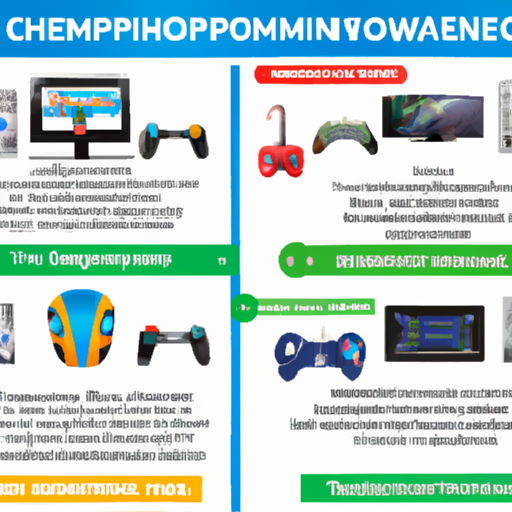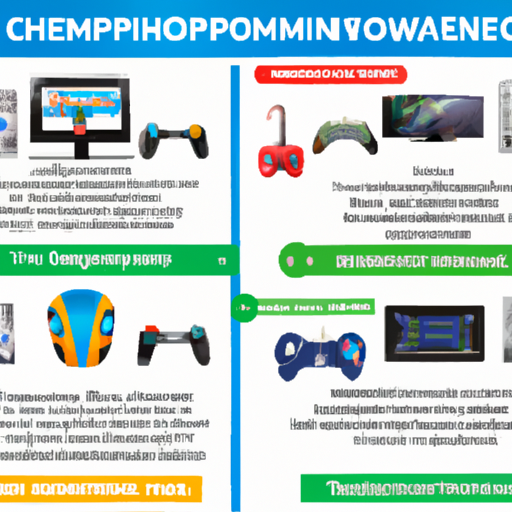Are you ready to embark on an epic gaming adventure? Look no further than “The Ultimate Showdown: Comparing Gaming Experiences on Different Video Game Consoles.” This article will take you on a thrilling ride as we explore the gaming experiences offered by various video game consoles. From the stunning graphics of the latest PlayStation to the seamless multiplayer capabilities of the Xbox, we will delve into the unique features and strengths of each console. So, grab your controller and get ready to discover which console reigns supreme in the world of gaming. Let the ultimate showdown begin!

Graphics and Visuals
Resolution and Frame Rate
When it comes to the graphics and visuals of a video game console, two key factors to consider are the resolution and frame rate. Resolution refers to the number of pixels displayed on the screen, while frame rate refers to the number of frames that are displayed per second.
High-resolution graphics can greatly enhance the visual experience of a game, allowing for more detail and clarity. Most modern consoles offer at least 1080p resolution, with some even supporting 4K resolution. Additionally, the frame rate plays a vital role in providing smooth and fluid gameplay. A higher frame rate, such as 60 frames per second (FPS) or even 120 FPS, can make a significant difference in the responsiveness and overall enjoyment of a game.
Graphics Processing Power
The graphics processing power of a console is another crucial aspect to consider. This refers to the ability of the console to handle complex graphical calculations and render stunning visuals in real-time. Consoles with more powerful GPUs can deliver more realistic graphics, lifelike character animations, and breathtaking special effects.
Some consoles even offer advanced features such as ray tracing, which allows for accurate light and shadow rendering, further enhancing the immersion and visual fidelity of games. Furthermore, consoles with higher graphics processing power often have the capability to handle more demanding games, ensuring a smoother and more enjoyable gaming experience.
Artistic Style and Aesthetics
While technical specifications and graphics processing power are important, artistic style and aesthetics also play a significant role in enhancing the gaming experience. Different consoles may have unique approaches to art direction, resulting in varied visual styles and atmospheres.
Some consoles focus on hyper-realistic graphics, aiming to replicate real-world visuals as accurately as possible. Others might opt for a more stylized or cartoony art style, which can be visually appealing and create a distinct atmosphere. The choice of artistic style ultimately depends on personal preference, as some gamers may prefer a more realistic experience while others enjoy the charm of a stylized world.
Game Library
Exclusives
One of the factors that can greatly influence the gaming experience on a console is the availability of exclusive titles. Exclusive games are those that are only available on a particular console, and often showcase the console’s capabilities and unique features.
A strong lineup of exclusive games can provide gamers with an incentive to choose a specific console. These exclusive titles often push the boundaries of what is possible in gaming, serving as a showcase for the console’s hardware and capabilities. Whether it is the iconic characters and worlds of the Nintendo franchises, the cinematic storytelling of Sony exclusives, or the vast open-world adventures of Xbox exclusives, each console offers a selection of games that cannot be experienced anywhere else.
Variety of Genres
Another important aspect of a console’s game library is the variety of genres available. A diverse range of genres ensures that gamers with different preferences can find something that suits their tastes.
From action-packed shooters and immersive role-playing games to relaxing puzzle games and engaging simulation titles, a varied game library caters to a wide audience. Whether you enjoy the adrenaline rush of competitive multiplayer games or the captivating narratives of single-player adventures, a console with a rich selection of genres allows for a more fulfilling gaming experience.
Indie Games
In addition to the big-budget AAA titles, indie games also play a vital role in enhancing the gaming experience on a console. Indie games are often created by smaller development teams or even individual developers and offer unique gameplay experiences and creative storytelling.
Many consoles have embraced indie games, providing a platform for smaller developers to showcase their creativity and innovation. These games often bring fresh perspectives and new gameplay mechanics to the table, providing gamers with unique and memorable experiences. The availability of a vibrant indie game scene further enriches the game library of a console, offering a wide range of experiences beyond the mainstream titles.
Online Services
Multiplayer Experience
For many gamers, the online multiplayer experience is a crucial aspect of their gaming experience. Online multiplayer allows players to connect and compete or cooperate with others from around the world, adding a new level of excitement and engagement to their gaming sessions.
A console with a robust and reliable online multiplayer infrastructure can provide a seamless and immersive online gaming experience. Smooth matchmaking, secure online connections, and stable servers are essential for uninterrupted gameplay. Additionally, features such as voice chat, party systems, and online leaderboards further enhance the multiplayer experience, allowing players to communicate and compete with ease.
Online Communities
Online communities and social interaction are integral to the modern gaming experience. The ability to connect with fellow gamers, discuss strategies, and share experiences can greatly enhance the enjoyment of playing games.
Consoles with active and vibrant online communities offer opportunities for players to join gaming groups, participate in forums, and connect with like-minded individuals. These communities provide a sense of belonging and foster social interactions, allowing gamers to share tips, organize multiplayer sessions, and engage in friendly competition. The strength of the online community on a console can greatly contribute to the overall gaming experience and create a sense of camaraderie among players.
Subscription Benefits
Many consoles offer online subscription services that provide additional benefits and features to enhance the gaming experience. These subscription services often include perks such as free monthly games, exclusive discounts on game purchases, early access to demos and betas, and access to additional online features.
By subscribing to these services, gamers can expand their game library without additional costs, take advantage of special promotions, and enjoy an enhanced online experience. Additionally, some subscription services offer access to exclusive content or events, further enriching the overall value and enjoyment of the gaming experience.
Controller Design and Comfort
Ergonomics
The design and ergonomics of a console’s controller can greatly impact the comfort and ease of use during gameplay. A well-designed controller should fit comfortably in your hands, allowing for extended gaming sessions without discomfort or strain.
Controllers that have an ergonomic shape and intuitive button placement make it easier to access the various controls without having to stretch or strain your fingers. Additionally, controllers with textured grips and responsive buttons provide a tactile and satisfying gaming experience. A comfortable and ergonomic controller design is essential to ensure a seamless and enjoyable gaming experience.
Button Layout
The button layout and configuration of a controller can significantly affect the gameplay experience. Different consoles may have variations in button placement, leading to different muscle memory and control schemes for gamers.
A well-thought-out button layout allows for intuitive and precise control, ensuring that gamers can execute maneuvers and commands effortlessly. Consistency in button placement across different games also reduces the learning curve when transitioning between titles. Whether it’s the symmetrical layout of the Nintendo Switch Joy-Con, the offset analog stick placement on the Xbox controller, or the iconic shape and positioning of the PlayStation DualShock, each console’s button layout has its unique advantages and considerations.
Additional Features
Controllers also often come equipped with additional features that enhance the gaming experience. These can include features such as motion sensors, touchpads, force feedback, and customizable buttons.
Motion sensors, such as those found in the Nintendo Switch Joy-Con, allow for motion-controlled gameplay, adding a new dimension of interactivity to certain games. Touchpads, like the one on the PlayStation DualShock 4, provide an alternative input method and can be used for precise navigation or gesture-based controls. Force feedback, commonly known as rumble, provides tactile feedback to actions in the game, immersing players in the experience. Customizable buttons and profiles allow gamers to tailor the controller to their preferences, ensuring a personalized and comfortable gaming experience.

Backward Compatibility
Ability to Play Previous Generation Games
Backward compatibility refers to the ability of a console to play games from previous generations of that console. This feature allows gamers to revisit their favorite titles from previous consoles without the need for additional hardware.
Consoles that offer backward compatibility provide a seamless transition for gamers, ensuring that their game library remains accessible even when upgrading to a new console. The ability to play previous generation games ensures that gamers can experience their favorite titles or catch up on games they may have missed.
Availability of Remastered Versions
In addition to backward compatibility, some consoles also offer remastered versions of older games. Remastered games are updated versions of classic titles, featuring improved graphics, performance enhancements, and additional content.
Remastered games allow gamers to experience their favorite titles in a new light, with enhanced visuals and modernized gameplay. They can breathe new life into older games and introduce them to a new generation of players. The availability of remastered versions on a console adds value to the gaming experience, as it allows players to revisit beloved classics with improved quality and features.
Cross-Platform Compatibility
Cross-platform compatibility is another aspect of backward compatibility that is gaining prominence in the gaming industry. Cross-platform compatibility refers to the ability to play games with players on different platforms, such as playing a game on a console while competing against or cooperating with players on a different console or PC.
Consoles that offer cross-platform compatibility create a more inclusive multiplayer experience, allowing players to connect and play with a larger player base. This feature breaks down barriers between platforms, ensuring that gamers can enjoy their favorite games with friends, regardless of their choice of console.
Virtual Reality Capability
Hardware Requirements
Virtual reality (VR) capability is a relatively new frontier in console gaming, offering an immersive and interactive gaming experience. To support VR, consoles need to meet certain hardware requirements.
These requirements include powerful processors, high-resolution displays, and accurate motion tracking. As VR places a heavy load on a console’s hardware, it is essential for a console to have the necessary processing power to render VR environments in real-time. Additionally, a console’s ability to track the player’s motion accurately is crucial for delivering an immersive VR experience.
Selection of VR Games
The availability of a diverse and compelling library of VR games is essential for a console’s VR capability to be truly immersive. A strong selection of VR games allows gamers to explore new worlds, engage in thrilling experiences, and interact with virtual environments.
From exhilarating action-packed games to serene and mesmerizing experiences, a wide range of VR games caters to different preferences and interests. A console with a robust lineup of VR titles ensures that gamers can have access to a variety of immersive experiences, further enhancing the gaming experience.
Immersive Experience
Virtual reality has the potential to transport gamers into lifelike and seemingly real environments, creating a truly immersive experience. A console’s VR capability should be able to provide players with a sense of presence and engagement, blurring the lines between the real and virtual world.
Immersive VR experiences often make use of 3D audio, haptic feedback, and accurate head tracking to create a sense of realism and depth. These features combined with high-resolution displays allow gamers to look around, interact with virtual objects, and feel fully immersed in the virtual world. A console’s VR capability can provide a unique and captivating gaming experience, offering a level of immersion that is unparalleled by traditional gaming.

User Interface
Ease of Navigation
A user-friendly and intuitive user interface (UI) is essential to provide easy and efficient access to games, features, and settings on a console. The UI should be designed with the user in mind, making it simple and straightforward to navigate through menus and access different functions.
A console with an intuitive UI ensures that gamers can easily find and launch their games, manage their library, connect with friends, and customize their gaming experience. Well-organized menus, clear icons, and responsive navigation contribute to a seamless and enjoyable user experience.
Customization Options
Customization options allow gamers to personalize their console’s user interface, making it feel truly their own. From selecting different themes and backgrounds to organizing game libraries and creating custom profiles, customization options provide a sense of ownership and personalization.
The ability to customize the user interface to reflect personal preferences and gaming style adds value to the gaming experience. Whether it’s choosing a theme that matches their favorite game or rearranging the layout for easier access to frequently used features, customization options enhance the overall user experience on a console.
Social Integration
Social integration within the user interface of a console allows gamers to connect with friends, share achievements, and engage in social interactions. Features such as friend lists, messaging systems, and activity feeds create a social environment within the console, facilitating communication and collaboration.
The ability to easily connect with friends, invite them to multiplayer sessions, and share memorable gaming moments adds a sense of community and camaraderie. Social integration features enhance the overall gaming experience by fostering connections and enabling meaningful interactions with fellow gamers.
Performance and Loading Times
Processing Speed
The processing speed of a console plays a crucial role in providing a smooth and seamless gaming experience. Faster processors and ample RAM ensure that games can be loaded quickly and run smoothly without lag or stuttering.
A console with fast processing speed reduces loading times, allowing gamers to jump into gameplay faster and spend more time actually playing. Additionally, a console with ample RAM ensures that games can run smoothly even in graphics-intensive situations, maintaining a consistent frame rate and visual fidelity. The level of processing speed directly impacts the overall performance and enjoyment of gaming on a console.
Storage Medium
The storage medium of a console affects the loading times and storage capacity of games. Consoles typically utilize either traditional hard disk drives (HDDs) or solid-state drives (SSDs) for storage.
SSDs provide significantly faster loading times compared to HDDs, as they have no moving parts and can access data more quickly. This results in reduced loading screens and faster transitions between game levels or areas. Additionally, SSDs contribute to a more responsive and snappy user interface, making navigating menus and accessing different functions quicker.
System Updates
System updates are an essential part of the gaming experience as they provide bug fixes, security enhancements, and new features to enhance the overall performance of a console. Regular updates ensure that the console’s software remains up to date and optimized for the latest games and technologies.
A console with a streamlined and efficient system update process minimizes disruptions to gameplay and ensures that updates are downloaded and installed seamlessly. Timely updates that address known issues and improve system stability contribute to a smoother and more enjoyable gaming experience.

Price and Value
Console Cost
The cost of a console is an important consideration for gamers when evaluating the overall value and gaming experience it offers. Consoles vary in price, with different models catering to different budgets.
While budget-friendly consoles may offer a more affordable entry point, they may also have trade-offs in terms of hardware capabilities and features. On the other hand, more premium consoles often come with higher price tags but offer superior processing power, graphics capabilities, and additional features. The cost of a console should be weighed against its hardware specifications, game library, and overall value it provides.
Game Prices
In addition to the cost of the console itself, the pricing of games can significantly impact the overall gaming experience. Game prices can vary depending on factors such as popularity, exclusivity, and development costs.
Some consoles offer subscription services that provide access to a library of games at a fixed monthly price, allowing gamers to play a wide variety of titles without the need to purchase individual games. Other consoles may have lower game prices or more frequent sales, making it more affordable to build a game library. The availability and affordability of games should be considered when evaluating the long-term value and gaming experience of a console.
Additional Expenses
Aside from the initial cost of the console and game prices, there may be additional expenses to consider when evaluating the overall value and gaming experience on a console. These additional expenses can include accessories, online subscriptions, downloadable content (DLC), and peripherals.
Accessories such as extra controllers, charging docks, and gaming headsets can enhance the multiplayer experience and provide additional comfort and convenience. Online subscriptions often offer added benefits such as free monthly games and exclusive discounts. DLC allows gamers to expand their gaming experience with additional content and expansions. These additional expenses should be factored in when assessing the overall value and enjoyment of gaming on a console.
Future Proofing
Technological Advancements
Console gaming is an ever-evolving industry, and consoles that offer future-proofing features can ensure that gamers stay at the cutting edge of technology. Technological advancements in areas such as graphics processing power, storage capabilities, and connectivity options can greatly enhance the gaming experience.
Consoles that incorporate the latest hardware and technologies are better equipped to handle future game releases, deliver improved graphics and performance, and support emerging gaming trends. By investing in a console that embraces technological advancements, gamers can future-proof their gaming experiences and avoid the need for frequent hardware upgrades.
Hardware Upgrade Potential
While consoles are traditionally seen as closed systems, some consoles offer the potential for hardware upgrades. These consoles allow gamers to swap out certain components, such as storage drives or graphics cards, to improve performance or increase storage capacity.
The ability to upgrade hardware components gives gamers the flexibility to adapt their console’s capabilities to their changing needs and requirements. This potential for hardware upgrades can extend the lifespan of a console and ensure that gamers can continually enjoy high-quality gaming experiences without the need for a complete console replacement.
Longevity of Console Lifecycle
The longevity of a console’s lifecycle is an important consideration when evaluating the overall value and gaming experience. Consoles typically have a lifespan of several years, during which they receive support from developers in terms of new game releases and software updates.
A console with a longer lifecycle ensures that gamers can continue to enjoy new game releases and updates for a longer period. This extends the value and enjoyment of the gaming experience and reduces the need for frequent hardware upgrades. The longevity of a console’s lifecycle should be considered when making a long-term investment in a gaming platform.
In conclusion, when comparing gaming experiences on different video game consoles, there are various factors to consider. Factors such as graphics and visuals, game library, online services, controller design and comfort, backward compatibility, virtual reality capability, user interface, performance and loading times, price and value, and future-proofing all contribute to the overall gaming experience.
Each console offers its own unique features, strengths, and weaknesses, catering to different preferences and gaming styles. By considering these aspects, gamers can make informed decisions and choose the console that best suits their needs and provides the most enjoyable gaming experience. Happy gaming!

